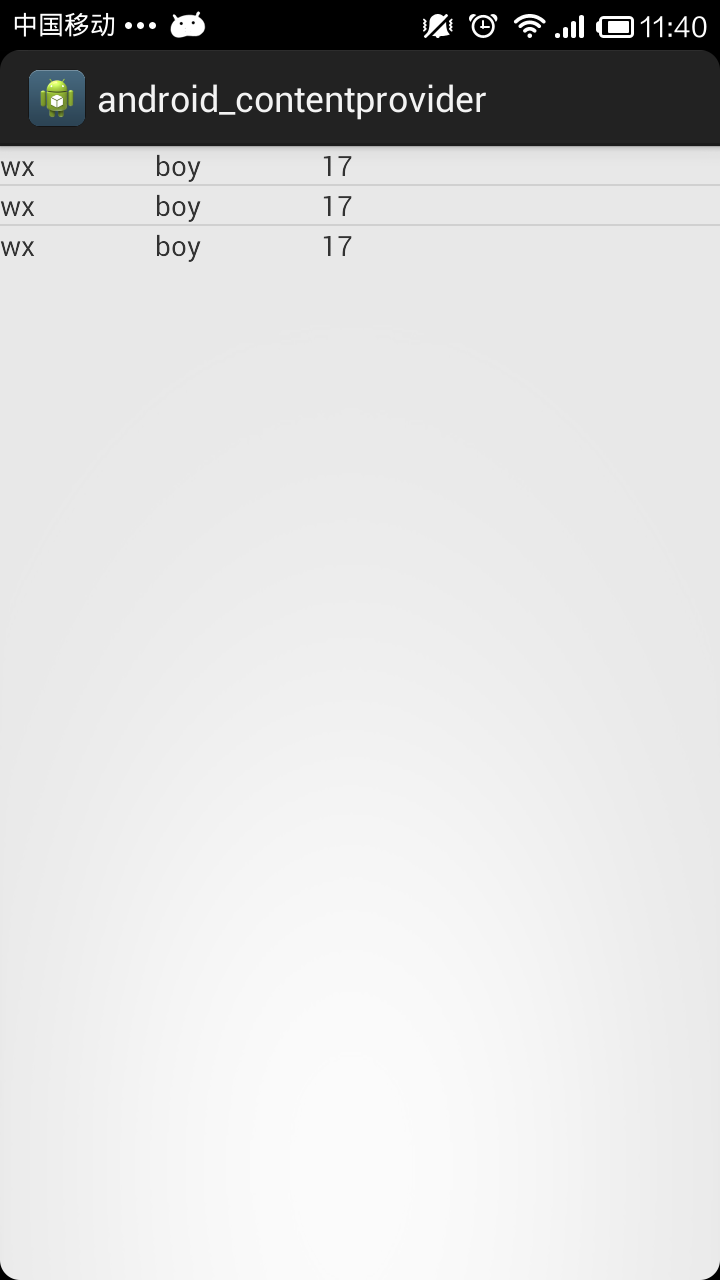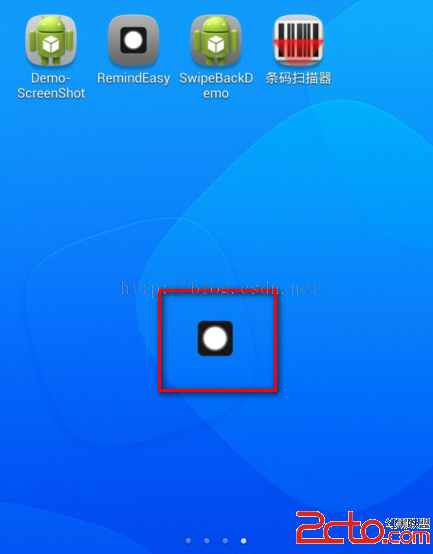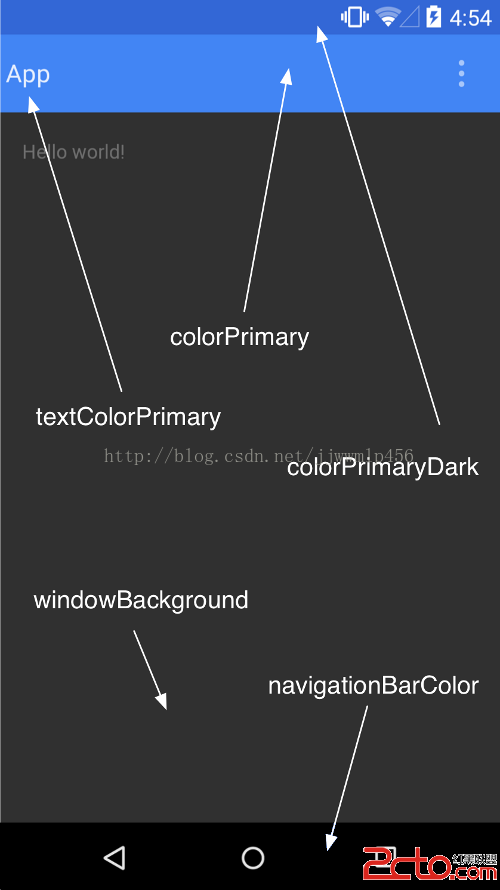編輯:關於Android編程
ContentProvider基本使用
為了在應用程序之間交換數據,android提供了ContentProvider,ContentProvider是不同應用程序之間進行數據交換的標准API,當一個應用程序需要把自己的數據暴露給其他程序使用時,該應用程序就可以通過提供ContentPRovider來實現,其他應用程序就可以通過ContentResolver來操作ContentProvider暴露的數據。
實現ContentProvider的步驟:
1)編寫一個類,繼承ContentProvider,並且重寫裡面的CRUD方法。
2)在androidmanifest.xml文件中注冊provider。
在androidmanifest.xml中注冊provider需要以下3個屬性:
android:name provider的實現類。
android:authorities provider的uri。
android:exported provider是否暴露給其他程序。
ContentResovler操作ContentProvider:
1)獲取ContentResolver,getContentResovler()方法來自於ContextWrapper,所以activity和service中都可以使用。
2)調用CURD方法,通過參數url,調用指定的ContentProvider的方法。
下面是一個demo,向contentProvider中插入一條數據,並且返回到listview中。
main.xml:
<RelativeLayout xmlns:android="http://schemas.android.com/apk/res/android"
xmlns:tools="http://schemas.android.com/tools"
android:layout_width="match_parent"
android:layout_height="match_parent"
tools:context=".Main" >
<ListView
android:id="@+id/listview"
android:layout_width="match_parent"
android:layout_height="wrap_content" />
</RelativeLayout>
MySQLiteOpenHelper類
package com.app.dao;
import android.content.Context;
import android.database.sqlite.SQLiteDatabase;
import android.database.sqlite.SQLiteDatabase.CursorFactory;
import android.database.sqlite.SQLiteOpenHelper;
public class MySQLiteOpenHelper extends SQLiteOpenHelper {
public MySQLiteOpenHelper(Context context, String name,
CursorFactory factory, int version) {
super(context, name, factory, version);
}
@Override
public void onCreate(SQLiteDatabase db) {
String create_sql = "create table tb_test(_id integer primary key autoincrement,name,gender,age)";
db.execSQL(create_sql);
}
@Override
public void onUpgrade(SQLiteDatabase db, int oldVersion, int newVersion) {
}
}
MyContentProvider類
package com.app.dao;
import android.content.ContentProvider;
import android.content.ContentValues;
import android.database.Cursor;
import android.net.Uri;
public class MyContentProvider extends ContentProvider{
MySQLiteOpenHelper helper=null;
@Override
public int delete(Uri arg0, String arg1, String[] arg2) {
return 0;
}
@Override
public String getType(Uri arg0) {
// TODO Auto-generated method stub
return null;
}
@Override
public Uri insert(Uri arg0, ContentValues values) {
String insert_sql="insert into tb_test values(null,'wx','boy',17)";
helper.getReadableDatabase().execSQL(insert_sql);
return null;
}
@Override
public boolean onCreate() {
helper=new MySQLiteOpenHelper(this.getContext(),"test.db3",null,1);
return true;
}
@Override
public Cursor query(Uri arg0, String[] arg1, String arg2, String[] arg3,
String arg4) {
String query_sql="select * from tb_test";
Cursor cursor=helper.getReadableDatabase().rawQuery(query_sql, null);
return cursor;
}
@Override
public int update(Uri arg0, ContentValues arg1, String arg2, String[] arg3) {
// TODO Auto-generated method stub
return 0;
}
}
listview的顯示界面show.xml
<?xml version="1.0" encoding="utf-8"?>
<LinearLayout xmlns:android="http://schemas.android.com/apk/res/android"
android:layout_width="match_parent"
android:layout_height="match_parent"
android:orientation="horizontal" >
<TextView
android:id="@+id/name"
android:layout_width="wrap_content"
android:layout_height="wrap_content" />
<TextView
android:id="@+id/gender"
android:layout_width="wrap_content"
android:layout_height="wrap_content"
android:layout_marginLeft="60dp" />
<TextView
android:id="@+id/age"
android:layout_width="wrap_content"
android:layout_height="wrap_content"
android:layout_marginLeft="60dp" />
</LinearLayout>
Main.java
package com.app.main;
import android.annotation.SuppressLint;
import android.app.Activity;
import android.content.ContentResolver;
import android.database.Cursor;
import android.net.Uri;
import android.os.Bundle;
import android.support.v4.widget.CursorAdapter;
import android.widget.ListView;
import android.widget.SimpleCursorAdapter;
public class Main extends Activity {
ContentResolver resolver = null;
ListView lv = null;
@SuppressLint("NewApi")
@Override
protected void onCreate(Bundle savedInstanceState) {
super.onCreate(savedInstanceState);
setContentView(R.layout.main);
lv = (ListView) this.findViewById(R.id.listview);
resolver = this.getContentResolver();
String str = "content://com.app.test.db/";
Uri uri = Uri.parse(str);
resolver.insert(uri, null);
Cursor cursor = resolver.query(uri, null, null, null, null);
SimpleCursorAdapter adapter = new SimpleCursorAdapter(this,
R.layout.show, cursor,
new String[] { "name", "gender", "age" }, new int[] {
R.id.name, R.id.gender, R.id.age },
CursorAdapter.FLAG_REGISTER_CONTENT_OBSERVER);
lv.setAdapter(adapter);
}
}
實現效果:(執行了3次插入後的效果)

ContentProvider的單元測試
ContentProvider是android的四大組件之一,在編寫代碼的時候最好是加上單元測試,這樣可以確定對數據的CRUD的正確。本篇文章主要介紹ContentProvider中兩個主要輔助類的使用還有單元測試的在ContentProvider中的使用。
需要用到的兩個輔助類:UriMatcher類和ContentUris類。
UriMatcher類:能夠對輸入的uri參數就行匹配,以確定對什麼表執行什麼樣的操作。
ContentUris類:有些方法需要返回uri,運用此類可以方便的生成uri類。
對於單元測試,個人覺得非常有必要在今後寫代碼的時候使用,這樣可以非常准確的確定代碼的正確性。
使用單元測試的步驟:
1)加入instrumentation,這個部分的代碼是固定,也可以完全在ADT提供的向導中導入。
<instrumentation
android:name="android.test.InstrumentationTestRunner"
android:targetPackage="com.example.android_contentprovider" >
</instrumentation>
2)添加<uses-library>,這個部分的代碼也是固定的寫法。
<uses-library android:name="android.test.runner" />
好了,必備的知識已經講完了,現在上代碼:
1)生成一個SQLiteDatabase類,這個是必需的類MySQLiteOpenHelper類
package com.app.db;
import android.content.Context;
import android.database.sqlite.SQLiteDatabase;
import android.database.sqlite.SQLiteDatabase.CursorFactory;
import android.database.sqlite.SQLiteOpenHelper;
public class MySQLiteOpenHelper extends SQLiteOpenHelper {
private static String DB_NAME = "test.db3";
private static int VERSION = 1;
public MySQLiteOpenHelper(Context context) {
super(context, DB_NAME, null, VERSION);
}
@Override
public void onCreate(SQLiteDatabase db) {
//建表語句
String create_student = "create table student(_id integer primary key autoincrement,name varchar(10),age integer,gender vachar(10))";
db.execSQL(create_student);
//千萬不能執行這句 // db.close();
}
@Override
public void onUpgrade(SQLiteDatabase arg0, int arg1, int arg2) {
}
}
然後添加我們需要的MyContentProvider類:
package com.app.contentprovider;
import com.app.db.MySQLiteOpenHelper;
import android.content.ContentProvider;
import android.content.ContentUris;
import android.content.ContentValues;
import android.content.UriMatcher;
import android.database.Cursor;
import android.database.sqlite.SQLiteDatabase;
import android.net.Uri;
import android.util.Log;
public class MyContentProvider extends ContentProvider {
MySQLiteOpenHelper helper = null;
private static UriMatcher matcher = new UriMatcher(UriMatcher.NO_MATCH);
// 匹配單條記錄
private static final int student = 1;
// 匹配多條記錄
private static final int students = 2;
static {
matcher.addURI("com.app.wx", "student/#", student);
matcher.addURI("com.app.wx", "student", students);
}
@Override
public int delete(Uri uri, String selection, String[] selectionArgs) {
SQLiteDatabase db = helper.getWritableDatabase();
int action = matcher.match(uri);
switch (action) {
// 匹配單條記錄
case student:
long id = ContentUris.parseId(uri);
//獲取單條記錄的id號
String delete_id = "_id=" + id;
if (selection != null) {
delete_id += delete_id + " and " + selection;
}
db.delete("student", delete_id, selectionArgs);
break;
// 匹配多條記錄
case students:
db.delete("student", selection, selectionArgs);
break;
}
return 0;
}
//必需實現這個方法,這個方法與intent有關系,以後再講
@Override
public String getType(Uri uri) {
int code = matcher.match(uri);
switch (code) {
case student:
return "vnd.android.cursor.item/student_item";
case students:
return "vnd.android.cursor.dir/students";
default:
return null;
}
}
@Override
public Uri insert(Uri uri, ContentValues values) {
SQLiteDatabase db = helper.getWritableDatabase();
int action = matcher.match(uri);
switch (action) {
case students:
long id1 = db.insert("student", "_id", values);
Log.i("--------", ContentUris.withAppendedId(uri, id1).toString());
return ContentUris.withAppendedId(uri, id1);
}
return null;
}
@Override
public boolean onCreate() {
helper = new MySQLiteOpenHelper(this.getContext());
return true;
}
@Override
public Cursor query(Uri uri, String[] projection, String selection,
String[] selectionArgs, String orderBy) {
SQLiteDatabase db = helper.getWritableDatabase();
Cursor cursor = null;
int action = matcher.match(uri);
switch (action) {
case students:
cursor = db.query("student", projection, selection, selectionArgs,
null, null, orderBy);
break;
}
System.out.println("-----------count:" + cursor.getCount());
return cursor;
}
@Override
public int update(Uri uri, ContentValues values, String selection,
String[] arg3) {
int count = -1;
SQLiteDatabase db = helper.getWritableDatabase();
int action = matcher.match(uri);
switch (action) {
case student:
// 以id來處理更新
long id = ContentUris.parseId(uri);
String id_selection = "_id=" + id;
if (selection != null && !selection.equals("")) {
id_selection = id_selection + " and " + values;
}
count = db.update("student", values, id_selection, arg3);
System.out.println("----------count:" + count);
break;
}
return count;
}
}
這個類很長,但是執行的方法都是比較常見的CURD的方法,重要的是UriMatcher和ContentUris類的使用。
接著執行單元測試類:Test
package com.app.contentprovider;
import android.content.ContentResolver;
import android.content.ContentValues;
import android.database.Cursor;
import android.net.Uri;
import android.test.AndroidTestCase;
import android.util.Log;
public class Test extends AndroidTestCase {
public void insert() {
ContentResolver resolver = this.getContext().getContentResolver();
String str = "content://com.app.wx/student";
ContentValues values = new ContentValues();
values.put("name", "wzq");
values.put("age", 18);
values.put("gender", "boy");
resolver.insert(Uri.parse(str), values);
}
public void update() {
ContentResolver resolver = this.getContext().getContentResolver();
String str = "content://com.app.wx/student/2";
ContentValues values = new ContentValues();
values.put("name", "哈哈");
resolver.update(Uri.parse(str), values, null, null);
}
public void query() {
ContentResolver resolver = this.getContext().getContentResolver();
String str = "content://com.app.wx/student";
Uri uri = Uri.parse(str);
Cursor cursor = resolver.query(uri, new String[] { "_id",
"name,age,gender" }, null, null, "_id desc");
Log.d("------count",cursor.getCount()+"");
}
public void delete() {
ContentResolver resolver = this.getContext().getContentResolver();
String str = "content://com.app.wx/student/2";
Uri uri = Uri.parse(str);
long id=resolver.delete(uri, null, null);
}
}
執行insert方法之後(執行了三次):

執行了update方法之後:

執行了query方法之後:

執行了delete方法之後:

 Android仿IOS的AssistiveTouch的控件EasyTouch實現
Android仿IOS的AssistiveTouch的控件EasyTouch實現
概述:之前我聽到過一則新聞,就是說Ipone中的AssistiveTouch的設計初衷是給殘疾人使用的。而這一功能在亞洲(中國)的使用最為頻繁。雖不知道這新聞的可靠性,但
 Android(Lollipop/5.0) Material Design(三) 使用Material主題
Android(Lollipop/5.0) Material Design(三) 使用Material主題
官網地址:https://developer.android.com/intl/zh-tw/training/material/theme.html 新的Material
 Android自定義ActionProvider ToolBar實現Menu小紅點
Android自定義ActionProvider ToolBar實現Menu小紅點
今天的幾個目標: 1. 自定義ActionProvider 2. Toolbar ActionBar自定義Menu 3. Toolbar ActionBar 右側Menu
 手機qq提示異地登陸怎麼辦 如何加強手機qq安全管理
手機qq提示異地登陸怎麼辦 如何加強手機qq安全管理
我們的qq有時候會有異地登陸的提示,這是怎麼回事呢?難道我們的qq號被盜了?如何才能加強手機qq的安全管理?下面我們就一起來看看吧!1、大家登錄自己的QQ賬